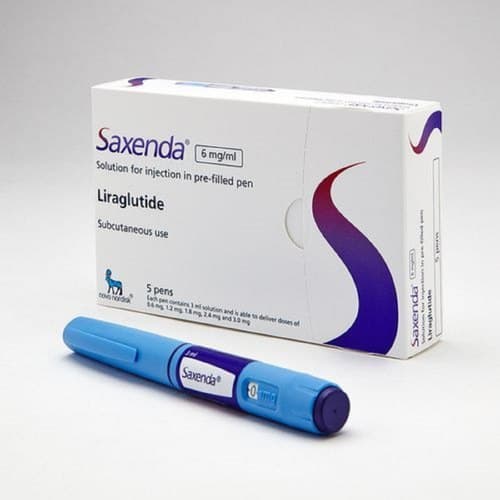USA Script Helpers takes a look into Saxenda. Buy Canadian Insulin for a fraction of the cost compared to the USA. Did you know that Americans can buy Saxenda from Canada? USA Script Helpers offers Canadian sourced medications that you can rely on. That includes Saxenda. This medication is insulin that is used with a doctor-approved exercise, behavior change, and reduced-calorie diet program this medication was created to help you lose weight. It is used by certain overweight people, such as those who are obese or have weight-related medical problems. Losing weight and keeping it off can lessen the many health risks that come with obesity, including heart disease diabetes, high blood pressure, and a shorter life.
Liraglutide is similar to a natural hormone in your body (incretin). It works by suppressing and controlling your appetite.
It is a glucagon-like peptide-1 receptor agonist and should not be used in combination with any other drug belonging to this class, including Victoza, a treatment for type 2 diabetes; while Saxenda and Victoza contain the same active ingredient (liraglutide) at different doses, Saxenda is not indicated for the treatment of type 2 diabetes, as the safety and efficacy of Saxenda for the treatment of diabetes has not been established. The cardiovascular safety of liraglutide is being investigated in an ongoing cardiovascular outcomes trial.
Chronic diseases like obesity usually require long-term treatment. Avoid taking gimmicks that will only lead to temporary weight loss. Be sure to do your homework. Look into obesity or whatever you think that you may have. Your health care provider will create a plan tailored to your weight-management goals. You’ll need to visit your health care provider 4 months after you begin taking Saxenda to review your progress and renew your prescription. You’ll also work with your health care provider to follow a low-calorie meal plan and increase your physical activity while taking Saxenda for weight management.
CAN YOU USE SAXENDA? WHO CAN USE THIS MEDICATION?
Saxenda is licensed to treat obesity in people with a body mass index (BMI) of 30kg/m2 or higher, or those with a BMI of 27kg/m2 to 30kg/m2 who have one or more of a number of weight-linked health conditions including Type 2 diabetes mellitus, hyperlipidemia (raised fat or cholesterol levels in the blood), high blood pressure and obstructive sleep apnea. It should be used in combination with a reduced-calorie diet and regular exercise. Children and young people under the age of 18 should not use Saxenda, as it is not yet known how the drug affects this age group. Furthermore, Saxenda should not be used by pregnant or breastfeeding women due to unknown effects on the fetus or baby.
WATCH OUT FOR SIDE EFFECTS:
Nausea,vomiting, stomach upset, diarrhea, gas, heartburn, or constipation may occur. Nausea usually lessens as you continue to use liraglutide. If any of these effects persist or worsen, tell your doctor or pharmacist promptly. Remember that your doctor has prescribed this medication because he or she has judged that the benefit to you is greater than the risk of side effects. Many people using this medication do not have serious side effects.
Persistent vomiting/diarrhea may result in a serious loss of body water (dehydration). Contact your doctor promptly if you notice any symptoms of dehydration, such as unusual dry mouth/thirst or dizziness/lightheadedness. Tell your doctor right away if you have any serious side effects, including signs of kidney problems (such as a change in the amount of urine), yellowing eyes/skin, fast heartbeat, mental/mood changes (such as depression, thoughts of suicide), signs of low blood sugar (sudden sweating, shaking, fast heartbeat, hunger, blurred vision, dizziness, or tingling hands/feet).
Get medical help right away if you have any very serious side effects, including signs of pancreatitis or gallbladder disease (such as persistent nausea/vomiting, severe stomach/abdominal pain). A very serious allergic reaction to this drug is rare. However, get medical help right away if you notice any symptoms of a serious allergic reaction, including rash, itching/swelling (especially of the face/tongue/throat), severe dizziness, trouble breathing.
MAKE SURE TO MONITOR HOW YOUR BODY REACTS TO SAXENDA:
You should talk to your doctor to make sure Saxenda is safe for you. Your health care provider will evaluate your health history and your medical conditions to decide if you can use the medication and if it is likely to improve your health. Do not share your Saxenda pen with others even if the needle has been changed. You may give other people a serious infection or get a serious infection from them.
AVOID USING SAXENDA IF:
If you have any severe allergies to Liraglutide or any of the ingredients in Saxenda.
You are expecting a child or trying to get pregnant. Saxenda may harm your unborn baby. Ask your doctor about breastfeeding if you are on Saxenda.
Before taking Saxenda, Consult with your Primary Physician:
– Advise your medical professional if you have severe problems with your stomach such as constipation, gastro, bowel movements from problems with the digestive system, problems with large or small intestines
– Alter your medical professional regarding any problems of the pancreas, kidneys, or liver.
– Alert your medical professional if you experience any depression or suicidal thoughts – this includes mental health issues
Be sure to tell your doctor or local Pharmacist regarding any prescription or over-the-counter medicines that you may currently be taking including vitamins, and herbal supplements. Did you know that Saxenda slows stomach emptying and can affect medicines that need to pass through the stomach quickly. This is why it is important for patients to advise their doctors of any medications they are currently or have recently stopped taking. Saxenda may affect the way some medicines work and some other medicines may affect the way Saxenda works. Tell your health care provider if you take diabetes medicines, especially insulin and sulfonylurea medicines.
Important disclaimer: The material created in this article is for public awareness and should not be taken as medical advice. To seek medical advice please speak to your local primary medical professional or give us a call at 1 (888) 646-7749 to request to speak to our contracted Pharmacy department. One of the Pharmacists will be glad to assist you.
USA Script Helpers is an established Pharmacy partner located in Winnipeg, Manitoba Canada. USA Script Helpers retails insulin through our contracted licensed Pharmacy Department. Buy Insulin in Canada at affordable prices. USA Script Helpers is open 365 days a year to help serve Americans. Toll free phone number: 1 (888) 646-7749.
Related Articles:


















